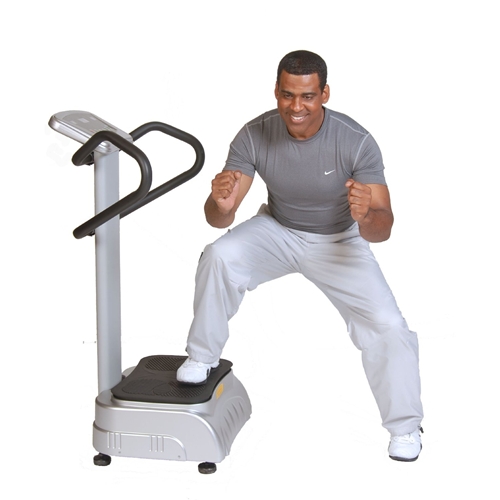Whole body vibration
Vibration training, also Whole Body Vibration ( WBV ) training acceleration or stochastic resonance training called, is a training method in which the exercising person is standing on a vibrating plate that vibrates at a frequency range of about 5 to 60 Hz. This stretch reflexes of the muscles are triggered and muscle contractions are caused. In the related methods of biomechanical stimulation ( BMS) or biomechanical oscillation, however, local muscle groups directly or via the associated tendons are stimulated by special vibration devices. Vibration training is offered in a variety of areas ( competitive sports, fitness, rehabilitation, medicine, care, beauty ) and used to increase performance of muscles and improve coordination and balance.
History
Vibrating massage tools were tested in medicine for a long time. 1869 began the American George Taylor a apparatus for vibration therapy of arm and back. Jean -Martin Charcot experimented in 1880 with a vibrating chair for the treatment of Parkinson 's disease. Gustav Zander ( Sweden) developed over 70 different steam-powered equipment for Mechano - Therapy. John Harvey Kellogg sat in his Battle Creek Sanatorium, a vibrating chairs and vibrating manipulators for arms and legs. Published in 1960 the East German W. Biermann, the effect of so-called " cyclic oscillations " on the human body. By 1970, Vladimir Nazarov tried, member of the Soviet national gymnastics team, the transfer of the beer man 's idea into practical training methods for which ever since the terms Biomechanical Stimulation ( BMS), have established biomechanical oscillation.
Since 1996 devices are offered in the free trade on which the exerciser can stand and thus enable a holistic training of both the extremities and the trunk muscles. For training with this device group, the terms Whole Body Vibration ( WBV ) Vibration training, Acceleration Training and stochastic resonance training have been established. The concept of Whole Body Vibration ( WBV ) has been occupied since it was originally in the field of occupational safety includes the effects of forces acting on a body vibrations, for example from vehicles or heavy equipment, however.
Effect
To the effect of vibration training, there are numerous studies with conflicting results, mostly on very small subjects or patient groups. Frequencies below about 12 Hz to stimulate the postural system. Vibrations above a frequency of about 12 Hz stretch reflexes are triggered and thus muscle contractions caused, which should increase ( called primarily type II fibers ( FT ) fiber, also called " fast muscle " ) muscle performance and counteract the bone loss. Vibration training devices should lead to bone slight elastic deformation and stimulate its growth. Just five minutes a day should be sufficient for eight weeks from 4.6 percent to reduce bone loss bedridden patients to 0.6 percent and prevent muscle breakdown. In volleyball players or field hockey players an increase in jump height of up to 10 percent could be achieved within three months. In a 12-week vibration training the blood sugar levels could be reduced in type II diabetes mellitus. Initial positive experience there was in patients with cerebral palsy. In older people, an increase of efficiency and coordination was achieved. In contrast, came in stroke patients a study found that daily whole-body vibration brought no advantage compared to ordinary exercise therapy, and a meta-analysis published in 2007 showed no improvement in muscle strength and jumping ability of athletes through vibration training.
Device variants
There are vertically vibrating systems ( the entire tread surface moves up and down) and side-alternating systems (function similar to a rocker) offered. Side-alternating systems supporting a frequency range of about 5 to 35 Hz, vertically vibrating systems a frequency range of 20 Hz to 60 Hz, the displacement is carried out technically mechanically or drives an eccentric mass, the rubber or of spring-loaded tread. Some devices can be switched between a vertical and a side-alternating mode, where the usable frequency range to low frequencies is significantly limited.
High frequency components lead to the known from the OSH negative impacts, such as when working on the jackhammer. Good vibration training equipment must ensure that potentially harmful frequency components can not be introduced into the body.
Swell
Recommendations of the ISMNI for the publication of vibration training studies
- Rauch F, Sievanen H, Boonen S, Cardinale M, Degens H, Felsenberg D, Roth J, Schoenau E, Verschueren S, Rittweger J: Reporting whole- body vibration intervention studies: Recommendations of the International Society of Musculoskeletal and Neuronal Interactions, J. Musculoskelet Neuronal Interact, 10 (3) :193-8, 2010; PMID 20811143



.jpg)






